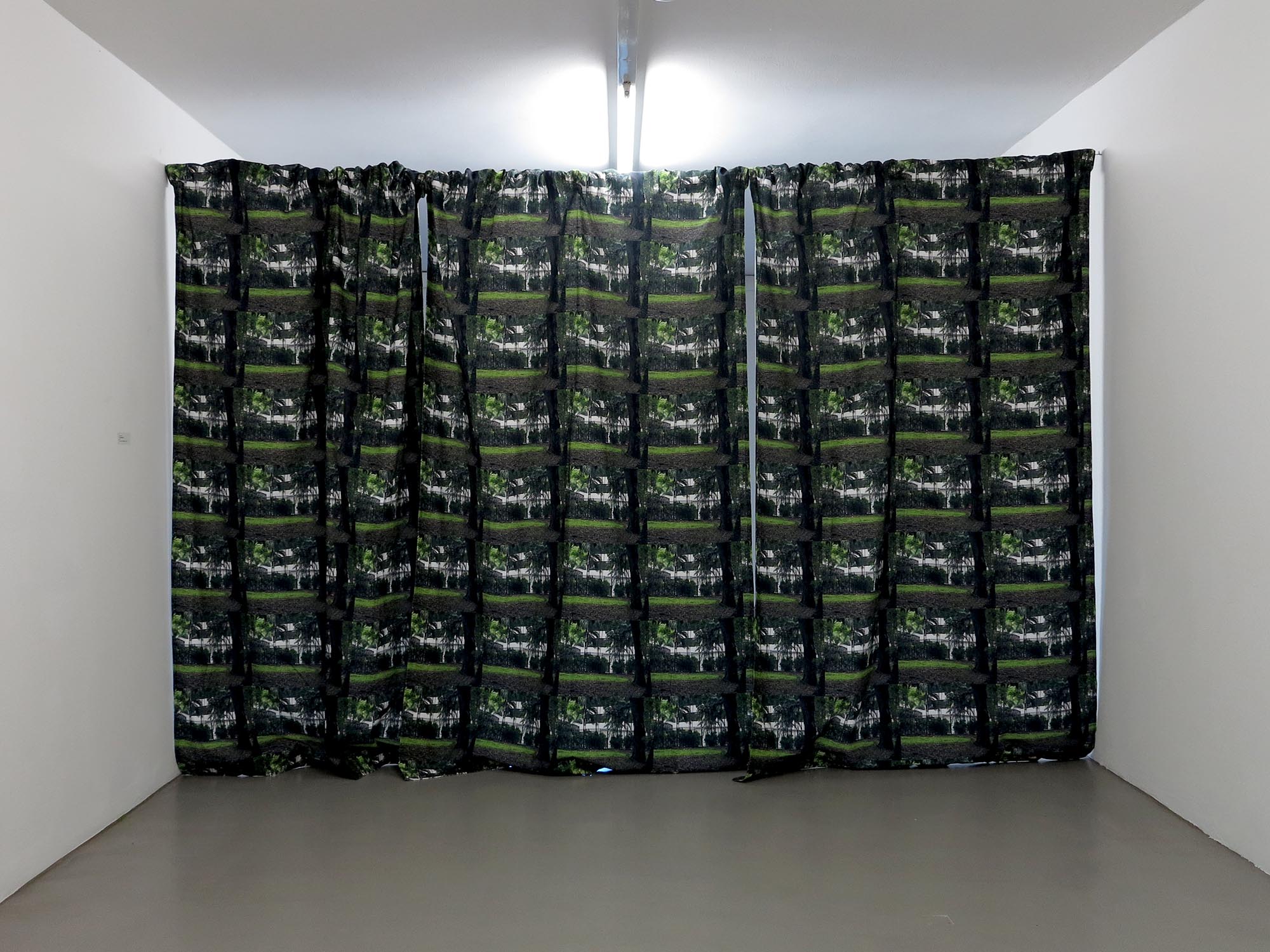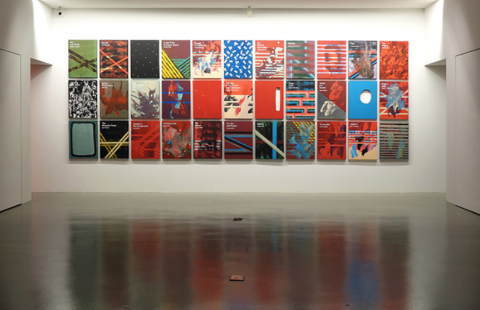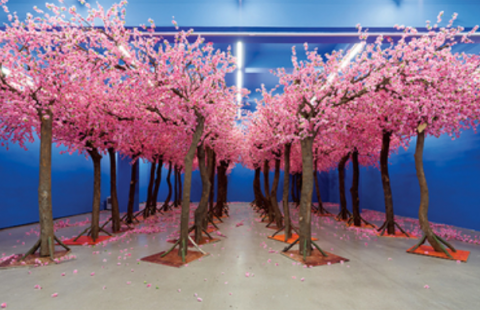Heman Chong is an artist whose work is located at the intersection between image, performance, situations and writing. His practice can be read as an imagining, interrogation and sometimes intervention into infrastructure as an everyday medium of politics.
His work has been the subject of solo exhibitions at Het Nieuwe Instituut, Weserburg Museum, Jameel Arts Center, Swiss Institute New York, Art in General, Artsonje Center, Rockbund Art Museum, South London Gallery, NUS Museum, amongst many others.
Chong is the co-director and founder (with Renée Staal) of The Library of Unread Books, a library made up of donated books previously unread by their owners.

Foreign Affairs is a series of banal photographs of embassy backdoors. The systematic repetition of images simultaneously recalls a cinematic frame and the omnipresence of the surveillance camera that watches nothing and everything. As a literal and cumulative representation of embassy backdoors, each image of a backdoor can be read as infrastructural, making apparent the very form of the non-descript embassy backdoor and its component parts: greenery as camouflage, the lone face of a strategically positioned surveillance camera, the additional lock or additional gates. These banal representations are the threshold of the exceptional space of the embassy, which in and of itself is the physical manifestation of an agreement between two states of respective sovereignty.
Foreign Affairs speak to the sites of infrastructural power in society today. They implicitly point to society’s real fears of ‘back door’ agreements, actors invisibly and insidiously pulling the strings behind the veil of the everyday. As representations of information, the images of the two different series reflect both the front and back stage upon which fears of international conflict, calamity and national disaster play out and/or are produced.
Infrastructure has been described as the “overt point of contact and access, where the underlying rules of the world can be clasped in the space of Everyday life”. Infrastructures are, by design, made to be banal and invisible as part of their everyday operations. Chong’s oeuvre can be read as an imagining, interrogation and sometimes intervention into infrastructure as an everyday medium of politics. His works are ecological systems that take on a diversity of forms such as the book, the painting, the performance, the magazine advertisement, the party, the process of writing a novel, the social contract of an exhibition etc. Chong’s work in its adoption of conventions (such as the cinematic frame or the calendar) casts a shrewd lens upon on how the world and our fear of what lays behind the curtain of the everyday is produced.
Text by Kathleen Ditzig. Image: Courtesy the Artist.

The Library of Unread Books is an itinerant library initiated by Heman Chong and Renée Staal. It is a living reference library with a collection of over 2000 titles, that traces the perimeters of knowledge and reflects on notions of access, excess and the politics of redistribution.
Every single book you find in the collection was once private property and has been donated by an individual who did not read it when it was in their possession. Contributors to the growing mobile library receive a personalised library card and a lifetime membership.
The Library of Unread Books brings to light these once-hidden-away titles to emphasize shared knowledge. The books, which are accessible to anyone who can visit the library sites, work to create a commons.
The books of The Library of Unread Books are arranged randomly and in stacks, in a setting that encourages visitors to feel at home and re-arrange the books according to will and desire.
Reminding us that a (private) library is both a means to an end and a research tool rather than an accessory, Umberto Eco famously called for an “antilibrary” made up of unread books. The novelist and scholar argued that read books are far less valuable than the unread ones and that a library should contain as much of what one does not know as finance might allow. “You will accumulate more knowledge and more books as you grow older, and the growing number of unread books on the shelves will look at you menacingly.”
In the case of this library of unread books, access to knowledge is not contingent on finance, and so the books are reverted back to a common resource pool.
Heman Chong. Image: Courtesy the Artist.

Started in 2003, Stacks is an ongoing sculptural project in which Heman Chong depicts banal everyday items—a glass or mug, a bottle of perfume—atop a stack of books. Produced once per year, each work’s title derives from the book titles contained therein; for example: Black Holes & Time Warps, The Possibility of an Island, The Practice of Everyday Life, Voyage to the End of the Room (all, 2006). As sculptures, each stack of books is intended for display directly on the oor instead of upon plinths or shelves. This serves to remind viewers of the works’ modest beginnings and to detract from assumptions that these mundane items are being elevated to the status of art object. It also keeps them resolutely human-scaled —a relevance that is important, given that the books and glassware comprising each stack are direct representations of items the artist has consumed in the previous year. In this sense, they are both a punctuation mark—announcing the end of one phase in life and the beginning of another—and allegorical totems to Chong’s recent past. Stacks also reflects the artist’s predilection for using art to point, recommend or redirect toward something else outside the immediate frame. These works may be seen as periodic self-portraits or conceptual mixtapes— but they also draw important parallels between everyday forms of consumption and the consumption of knowledge. In another light, they demonstrate Chong’s commitment to conceptualism by reassembling, rearranging and bringing attention to what is already present.
Amanda Lee-Koe. Image: Courtesy the Artist.

In an interview published by the Smithsonian on their website, Chris Carter, the creator and writer of The X-Files said something about the now ubiquitous ‘I want to believe’ poster that peaked my interest. He said, ‘The original graphic came from me saying, “Let’s get a picture of a spaceship and put—Ed Ruscha-like—“I want to believe.” I love Ed Ruscha. I love the way he puts text in his paintings. (I actually got to say to him, “I was inspired by you.”)’. I made this work for an exhibition curated by Simon Castets in Swiss Institute in New York. The invitation to the show was to think of a new work that related to props or settings you would find in films or on television. I like that by making a new version of ‘I want to believe’, by replacing it the UFO with a deep, dark, black hole, and giving the work away for free, that we can now all want to believe.
You can download the high resolution file for this work and print it for yourself. You can print it in whatever size you want, on whatever material you wish. Here is the link: https://goo.gl/V5s24u
Heman Chong. Image: Courtesy the Artist.

Memories is a series of performative and participatory transactions. Its parameters consist of a short story containing 499 words written by Heman Chong that are exchanged between two individuals: an instructor who holds a copy of the text, and a participant who has to learn the story verbatim, before he or she is allowed to leave the room.
The work posits a unique form of conversing, romantic in its transience and traumatic in its exactness. The exchange is based on factors of time and mental energy. In return for his or her time (the process can take up to three hours), the participant “receives” a gift; in this case, a memorized short story. It is a transaction where conventional definitions of receipt and value are challenged, and where the process of memorization creates an intimate bond between “teacher” and “student,” as both are united in reaching the goal of committing the story to memory.
Memories reveals Chong’s ongoing interest in stretching the modes and boundaries of exchange. The motif of exchange is reflected across a variety of the artist’s work, be it in the tutorials of Advanced Studies . . . (Ten Lessons for Life) or in the literal currency of A Short Story About Money And Fathers (for CELR). Expending one’s time in exchange for an artwork — or in this case, a narrative interlude — is an attractive feature for Chong, insofar as it offers a chance to reexamine and recalibrate the ways in which economies of art are commonly based on production and profit, and to move toward a model that embraces the intangible space of interhuman connections.”
Text by Amanda Lee-Koe. Image: Courtesy the Artist.
Press
-

Review
Ned Carter Miles, Review of Heman Chong: An Arm, a Leg, and Other Stories, South London Gallery, 2015. Aesthetica, January 25th, 2016. Installation view. Image: Courtesy the Artist and Amanda Wilkinson, London. Photography: Andy Keate.
-

Review
Michael Lee, Heman Chong’s “Of Indeterminate Time Or Occurrence”, Art Agenda, April 18th, 2014. Image: Courtesy Fost Gallery, Singapore
-

Review
Fiona He, Heman Chong, Rockbund Art Museum, Artforum, May 2016, Image: Heman Chong, The Mysterious Island, 2016, wood, plastic, iron wire, silk, paint. Installation view.